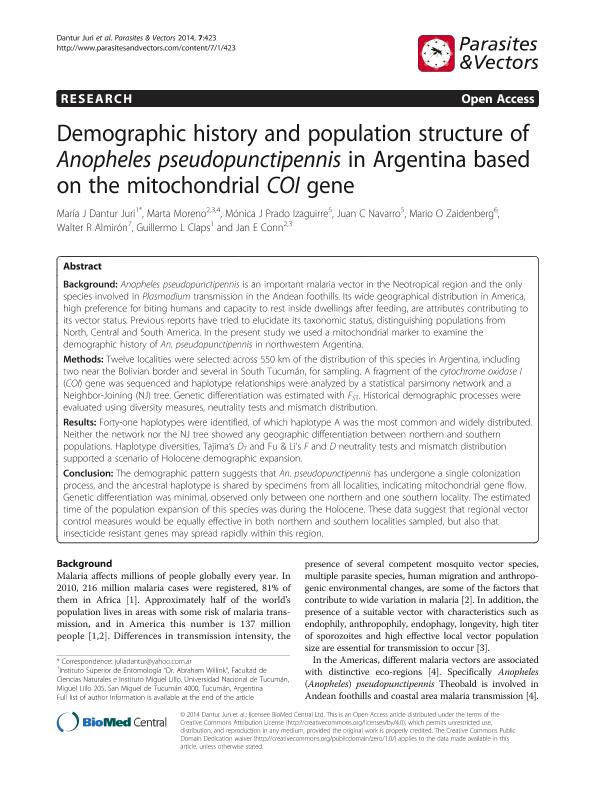Artículo
Demographic history and population structure of Anopheles pseudopunctipennis in Argentina based on the mitochondrial COI gene
Dantur Juri, Maria Julia ; Moreno, Marta; Prado Izaguirre, Mónica J.; Navarro, Juan C.; Zaidenberg, Mario O.; Almiron, Walter Ricardo
; Moreno, Marta; Prado Izaguirre, Mónica J.; Navarro, Juan C.; Zaidenberg, Mario O.; Almiron, Walter Ricardo ; Claps, Guillermo Luis
; Claps, Guillermo Luis ; Conn, Jan E.
; Conn, Jan E.
 ; Moreno, Marta; Prado Izaguirre, Mónica J.; Navarro, Juan C.; Zaidenberg, Mario O.; Almiron, Walter Ricardo
; Moreno, Marta; Prado Izaguirre, Mónica J.; Navarro, Juan C.; Zaidenberg, Mario O.; Almiron, Walter Ricardo ; Claps, Guillermo Luis
; Claps, Guillermo Luis ; Conn, Jan E.
; Conn, Jan E.
Fecha de publicación:
09/2014
Editorial:
Biomed Central
Revista:
Parasites And Vectors
ISSN:
1756-3305
Idioma:
Inglés
Tipo de recurso:
Artículo publicado
Clasificación temática:
Resumen
Background: Anopheles pseudopunctipennis is an important malaria vector in the Neotropical region and the only species involved in Plasmodium transmission in the Andean foothills. Its wide geographical distribution in America, high preference for biting humans and capacity to rest inside dwellings after feeding, are attributes contributing to its vector status. Previous reports have tried to elucidate its taxonomic status, distinguishing populations from North, Central and South America. In the present study we used a mitochondrial marker to examine the demographic history of An. pseudopunctipennis in northwestern Argentina.
Methods: Twelve localities were selected across 550 km of the distribution of this species in Argentina, including two near the Bolivian border and several in South Tucumán, for sampling. A fragment of the cytochrome oxidase I (COI) gene was sequenced and haplotype relationships were analyzed by a statistical parsimony network and a Neighbor-Joining (NJ) tree. Genetic differentiation was estimated with FS T. Historical demographic processes were evaluated using diversity measures, neutrality tests and mismatch distribution.
Results: Forty-one haplotypes were identified, of which haplotype A was the most common and widely distributed. Neither the network nor the NJ tree showed any geographic differentiation between northern and southern populations. Haplotype diversities, Tajima’s D T and Fu & Li’s F and D neutrality tests and mismatch distribution supported a scenario of Holocene demographic expansion.
Conclusion: The demographic pattern suggests that An. pseudopunctipennis has undergone a single colonization process, and the ancestral haplotype is shared by specimens from all localities, indicating mitochondrial gene flow. Genetic differentiation was minimal, observed only between one northern and one southern locality. The estimated time of the population expansion of this species was during the Holocene. These data suggest that regional vector control measures would be equally effective in both northern and southern localities sampled, but also that insecticide resistant genes may spread rapidly within this region.
Palabras clave:
Mosquitos
,
Anopheles
,
Coi
,
Argentina
Archivos asociados
Licencia
Identificadores
Colecciones
Articulos(CCT - NOA SUR)
Articulos de CTRO.CIENTIFICO TECNOL.CONICET - NOA SUR
Articulos de CTRO.CIENTIFICO TECNOL.CONICET - NOA SUR
Citación
Dantur Juri, Maria Julia; Moreno, Marta; Prado Izaguirre, Mónica J.; Navarro, Juan C.; Zaidenberg, Mario O.; et al.; Demographic history and population structure of Anopheles pseudopunctipennis in Argentina based on the mitochondrial COI gene; Biomed Central; Parasites And Vectors; 7; 423; 9-2014; 1-9
Compartir
Altmétricas



